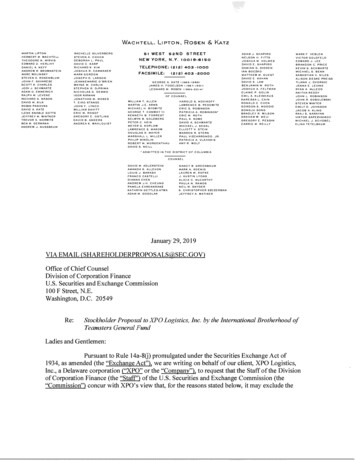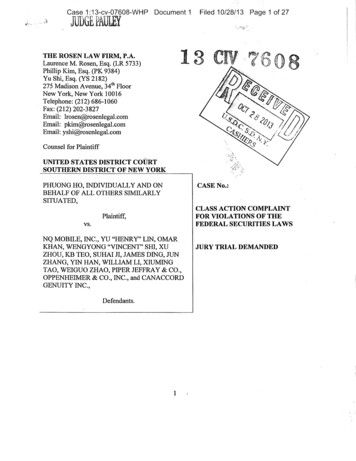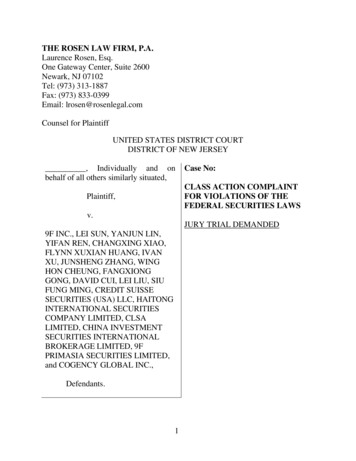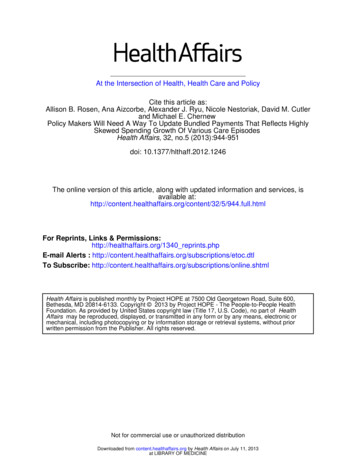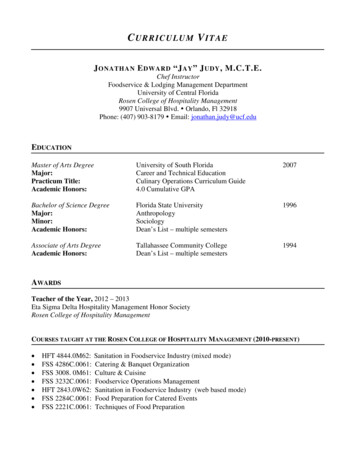
Transcription
Wachtell, Lipton, Rosen & KatzSpin-Off Guide2020
April 2020Wachtell, Lipton, Rosen & KatzAll rights reserved.
Spin-Off GuideTABLE OF CONTENTSPageI. Overview .1II. Initial Planning Considerations .3A.Reasons for Spin-Offs .3B.Separation Transaction Structures .4C.1.100% Spin-Off.52.Partial Spin-Off .63.IPO Plus Spin-Off / The “Up-C” Structure .64.IPO Plus Split-Off / Split-Off to LargeStockholder .85.Sponsored Spin-Offs .96.Spin-Offs Combined with M&A Transactions.107.REIT Separation Transactions.11Internal Process Considerations .11III. General Separation Issues .13A.Identification and Grouping of Businesses .13B.Capital Structure Considerations .14C.Allocation of Other Liabilities .17D.Solvency and Surplus.17E.Governance Considerations .18-i-
F.1.Duties of the Parent Board .182.Corporate and Governance Structuring of theSpin-Off Company .193.Takeover Defenses .214.Governance Following a Carve-Out IPO .24Management and Employee Matters .261.Composition of Employees .262.Allocation of Employee Benefits .263.Adjustments to Equity-Based CompensationAwards .27G.Consent Requirements .28H.Antitrust .29I.Intellectual Property .29J.Related-Party Arrangements .29K.Initial Disclosure of the Spin-Off .30L.Shareholder Vote .31IV. Transaction Agreements .33A.Generally .33B.Separation and Distribution Agreement.33C.Transition Services Agreement .36D.Tax Matters Agreement .36E.Employee Matters Agreement .37V. Securities Law Matters.39-ii-
A.Principal Securities Law Filings .39B.Eligibility of Subsidiary to Use Form S-3 .43C.Emerging Growth Company Status .44D.Other SEC Filings .44E.Obligations upon Effectiveness of the RegistrationStatement.45F.Investor Relations Activities .47VI. Tax Issues .49A.B.Generally .491.Requirements for Tax-Free Treatment .492.Procedural Considerations .51Spin-Offs Followed by Acquisitions .53VII. Listing and Trading Considerations .55A.Stock Exchange Listing .55B.“When-Issued” Trading .55C.The Distribution Ratio .56D.Reverse Stock Splits .56Annex AAnnex BIllustrative Sample Timetable for a Spin-OffPost-Spin Limitations on Strategic Transactions-iii-
I.OverviewA spin-off involves the separation of a company’s businesses through thecreation of one or more separate, publicly traded companies. Spin-offs have beenpopular because many investors, boards and managers believe that certainbusinesses may command higher valuations if owned and managed separately,rather than as part of the same enterprise. An added benefit is that a spin-off canoften be accomplished in a manner that is tax-free to both the existing publiccompany (referred to as the parent) and its shareholders. Companies have also beenable to tap the debt markets to lock in low borrowing costs for the business beingseparated and monetize a portion of its value. Spin-offs continue to be an importantoption that companies evaluate when assessing go-forward strategies: the totalvolume of completed spin-offs reached 179 billion in 2019, compared to 73billion in 2018. However, as of this writing, the COVID-19 pandemic is having asignificant impact on transaction activity, and it remains to be seen how it will affectspin-off activity.The process of completing a spin-off is complex. The issues that arise in anindividual situation depend largely on the business goals of the separationtransaction, the degree to which the businesses were integrated before thetransaction, the extent of the continuing relationships between the businesses afterthe transaction, the structure of the transaction and the desire to obtain (if possible)tax-free treatment of the spin-off. If the businesses were tightly integrated beforethe transaction or are expected to have significant business relationships followingthe transaction, it will take more time and effort to allocate assets and liabilities,identify personnel that will be transferred, separate employee benefits plans, obtainconsents relating to contracts and other rights, and document ongoing arrangementsfor shared services (e.g., legal, finance, human resources and informationtechnology) and continuing supply, intellectual property sharing and othercommercial or operating agreements. If the parent is expected to own a substantialportion of the spin-off company after the closing, careful planning is also requiredwith respect to the composition of the new company’s board, independent directorapproval of related-party transactions, handling of corporate opportunities andother matters. In addition to these separation-related issues, spin-offs raise variousissues associated with taking a company public, such as drafting and filing theinitial disclosure documents, applying for listing on a stock exchange,implementing internal controls and managing ongoing reporting obligations andpublic investor relations. These issues become more complex in a spin-off-1-
combined with an initial public offering or other capital markets transaction, or ina spin-off that is part of a larger merger or business combination.This guide is intended to help navigate the spin-off process, from thepreliminary phases through completion of the transaction. Part II of this guidedescribes some of the initial planning considerations relating to spin-offs, andincludes a discussion of the principal reasons for spin-offs and a comparison toother separation transactions. Part III examines a broad array of general corporateseparation issues that may arise in a spin-off. Part IV discusses the transactionagreements commonly executed to implement a spin-off and govern the post-spinrelationship between the parent and the spin-off company. Part V identifies theprincipal securities law matters associated with a spin-off. Part VI examines certaintax issues, which are critical given the tax-sensitive nature of separationtransactions. Finally, Part VII reviews stock exchange listing and tradingconsiderations. A sample illustrative timetable for a spin-off (that is not precededby an initial public offering) is attached as Annex A. A discussion of post-spinlimitations on strategic transactions is attached as Annex B.This edition of the guide reflects developments through April 2020.-2-
II.Initial Planning ConsiderationsA.Reasons for Spin-OffsThere are several drivers of spin-off activity. The principal reasons oftencited by companies for pursuing spin-offs include the following: Enhanced business focus. A spin-off will allow each business to focuson its own strategic and operational plans without diverting human andfinancial resources from the other business. Business-appropriate capital structure. A spin-off will enable eachbusiness to pursue the capital structure that is most appropriate for itsbusiness, strategy, and growth or cash flow profile. Each business mayhave different capital requirements that may not be optimally addressedwith a single capital structure. Distinct investment identity. A spin-off will create distinct and targetedinvestment opportunities in each business. A more “pure-play”company may be considered more transparent and attractive to investorsfocused on a particular sector or growth strategy, thereby counteractingthe “conglomerate discount” and enhancing the value of the business. Effectiveness of equity-based compensation. A spin-off will increasethe effectiveness of the equity-based compensation programs of bothbusinesses by tying the value of the equity compensation awarded toemployees, officers and directors more directly to the performance ofthe business for which these individuals provide services. Use of equity as acquisition currency. By creating a separately publiclytraded stock for part of the parent company’s businesses, a spin-off willenhance the ability of both the parent and the spin-off company to effectacquisitions using its stock as consideration.Shareholder activism is another potential driver of spin-off activity.Shareholder activists have become a powerful force in the corporate landscape, andmany activists agitate for “value maximizing” activity, including spin-offs. Forexample, Trian Fund Management ran a proxy fight for board representation atDuPont in 2015 and campaigned for a spin-off of DuPont’s agriculture, health andindustrial biosciences businesses. Although Trian did not win board representation,-3-
DuPont several months later agreed to merge with The Dow Chemical Company,which had also faced pressure from activist Third Point, and the two agreed thatpost-merger, they would separate into three new companies—an agriculturalchemicals company, a material sciences company and a specialty productscompany. In 2017, Honeywell announced the planned spin-offs of its home andADI global distribution businesses after pressure from Third Point. In fact, 2019saw a record high of 203 activist demands for breakups, spin-offs and split-offs, a21% increase from 2018.Although spin-offs often have strategic benefits, they also may involve avariety of costs and risks, including:B. the potential loss of both revenue and cost synergies due to theseparation of the parent’s businesses; disruptions to the business as a result of the spin-off; separation costs; reduced size and diversification, which could potentially result ingreater cash flow volatility and reduced access to capital markets, andwhich may affect credit ratings; the potential reduction of equity research coverage and investor focus ifthe separated companies are too small; the possibility of short-term stock price volatility as the market adjuststo the distinct investment identities of the separated companies; potential stock market index exclusion, depending on the size or natureof the companies; and the possible increased susceptibility to unsolicited takeover activity(given that the businesses of each of the two post-spin companies willbe less diversified and smaller than the combined predecessorcompany).Separation Transaction StructuresIt is common for a company in the initial planning phases to consider othertypes of separation transactions in addition to a spin-off. Separation transactionsgenerally can be divided into two categories: (1) a sale to a third party of the-4-
business being separated and (2) a sale to public stockholders or distribution to theparent company’s stockholders of the stock in a new public company holding thebusiness being separated. The decision as to which type of separation transactionto pursue depends on a variety of factors. A sale to a third party can often generatethe largest amount of cash proceeds to the parent. However, a sale or distributionof the stock in a new public company can often result in greater value to the parent’sshareholders because (1) the public market may place a higher value on the businessthan a third party and (2) a distribution of stock in a new public company to theparent’s shareholders may be tax-free to both the parent and its shareholders. Bycontrast, a sale for cash would be a taxable transaction, and, as compared to a spinoff, there is a greater risk that a sale to a third party may not be consummated. Also,the parent can generally determine the terms and timing of a spin-off, but a sale toa third party requires due diligence by the buyer and the negotiation and executionof a definitive agreement with respect to price, timing and other terms, and theclosing of such a sale will also typically be subject to various conditions over whichthe parent does not have complete control. Depending on the nature and size of thebusiness to be separated, there could be a relatively small universe of buyers thatmay be interested in and able to acquire the business. Purchase agreements withthird parties also often include various representations and warranties about thetarget business, supported by post-closing indemnities, and the parent may berequired to retain some or all of the historical liabilities of the business being sold.In a spin-off, on the other hand, the parent usually transfers the business to the spinoff company on an “as-is, where-is” basis, and the spin-off company typicallyassumes all of the historical liabilities of the business. Furthermore, it generally ispossible, in the context of a tax-free spin-off, for the parent to monetize a portionof the value of the spin-off company.Within the category of transactions involving the sale or distribution of thestock of a new public company, a variety of structures can be employed toaccomplish different financial and legal objectives, including those summarizedbelow.1.100% Spin-OffIn a typical 100% spin-off, all shares of the spin-off company are distributedto the shareholders of the parent as a dividend. This results in a full separation ofthe two entities in a single transaction.There are other corporate mechanics available for accomplishing a spin-off.For example, in 2005, IAC/InterActiveCorp (“IAC”) spun off Expedia through acharter amendment that reclassified each share of IAC common stock into a shareof IAC common stock and a fraction of a share of mandatory exchangeable-5-
preferred stock that automatically exchanged into a share of Expedia common stockimmediately after the reclassification. Because this structure involves a charteramendment, it requires a vote of the parent’s shareholders. By contrast, a spin-offaccomplished through a dividend usually does not require a shareholder vote underthe law of most jurisdictions.2.Partial Spin-OffIn some cases, the parent may distribute fewer than all of the shares of thespin-off company. Typically, the parent would not intend to retain the remainingshares long-term, but rather would use them to generate cash proceeds or to retireexisting debt of the parent, as discussed below in Part III.B. However, as describedbelow in Part VI, for a spin-off to be tax-free, the parent must generally distribute“control” (i.e., at least 80% of the voting power of all shares and at least 80% ofeach non-voting class of stock) of the spin-off company and must establish to thesatisfaction of the Internal Revenue Service that it has a valid business purpose forretaining any shares of the spin-off company. In addition, the parent must disposeof the retained shares of the spin-off company within five years following the spinoff for the transaction to be tax-free.3.IPO Plus Spin-Off / The “Up-C” StructureA parent may structure a separation transaction through an initial publicoffering of a portion of the common stock of the subsidiary to be separated followedby a distribution of the subsidiary’s common stock to shareholders of the parent.In the IPO, the subsidiary would sell a portion of its shares to the public in anunderwritten offering, with the proceeds either retained by the subsidiary ordistributed to the parent. An IPO allows the formation of a natural investor basefor the subsidiary in advance of distributing the remainder of the parent’s stake inthe subsidiary to the parent’s shareholders.Creating an investor base before a spin-off may be helpful because theshareholders of the parent on the record date for the spin-off dividend may or maynot wish to hold shares of the spin-off company. An IPO also allows for a tradingmarket and market valuation of the spin-off company to be established before thedistribution of the spin-off company stock to the parent’s shareholders.For the subsequent spin-off to qualify as tax-free, the parent must generallyretain shares representing at least 80% of the voting power in the subsidiary afterthe IPO, because the tax rules require the parent to distribute “control” (generally,at least 80% of the voting power of all shares and at least 80% of each non-votingclass of stock) of the subsidiary. An IPO followed by the distribution of the offering-6-
proceeds to the parent is generally tax-free to the corporations involved if theamount of cash distributed is less than the parent’s basis in the stock of thesubsidiary and certain other requirements are met. If the distribution of proceedsexceeds the parent’s aggregate tax basis in the stock of the subsidiary, the excesswould generally be includible in income of the parent either when the distributionoccurs or when the parent divests the subsidiary.Issuing low-vote stock to the public may preserve the ability to spin off thesubsidiary in a subsequent step if the parent wants more than 20% of the value ofthe stock of the subsidiary to be issued to the public. In 2016, the IRS announcedtwo safe harbors that allow the parent to utilize a “high-vote/low-vote” structure toobtain 80% control of a subsidiary without jeopardizing the tax-free status of asubsequent spin-off of such subsidiary. One safe harbor requires that thesubsidiary’s board of directors, management and certain controlling shareholderstake no action (including the adoption of any plan or policy) within 24 months ofthe spin-off that would unwind the “high-vote/low-vote” structure. The second safeharbor permits an unwind at any time after the spin-off if the subsidiary engages inan unanticipated third-party transaction (i.e., an acquisition as to which nodiscussions have occurred during the 24-month period before the spin-off and thereis less than 20% overlapping ownership of the subsidiary and the third-partyacquiror) that results in an unwind of the “high-vote/low-vote” structure. Further,the IRS may issue rulings regarding the tax consequences of a spin-off in which a“high-vote/low-vote” structure is put into place in anticipation of the spin-off.If the parent desires to sell to the public more than 20% of the stock of thesubsidiary while preserving the ability to spin off its remaining interest in thesubsidiary subsequently in a tax-free manner, an alternative to the traditional “highvote/low-vote” structure is to structure the subsidiary as an “Up-C.” An Up-Cstructure generally has the following characteristics: the business to be separated is contributed to an operating company thatis a limited liability company or limited partnership and is treated as apartnership for tax purposes; the public purchases low-vote stock in a newly formed corporation thatholds a minority economic interest in the operating company and amajority of the vote and control over the operating company; and the parent holds both non-economic high-vote stock in the newlyformed corporation giving it control over the corporation and at least a50% direct economic interest in the operating company.-7-
When the parent subsequently spins off its remaining interest after the IPO, theoperating company merges with the corporation.The Up-C structure allows the parent to sell up to 50% of the economics ofthe business being separated and, until it spins off the remaining interest, receivecash distributions from the operating company on a tax-efficient basis.Distributions can be received on a tax-efficient basis because the operatingcompany is a partnership for tax purposes rather than a non-consolidated corporatesubsidiary. The main downside of the structure is that the parent may pay tax onthe upfront proceeds from the IPO of the corporation.Some companies determine not to pursue a carve-out IPO because of theadditional costs (such as underwriting fees), complications and uncertaintyinvolved in an IPO. The timing of an IPO will depend in large part on equity marketconditions, which could significantly delay the completion of the transaction. AnIPO also raises governance issues because the parent continues to control thesubsidiary between the time of the carve-out IPO and the later spin-off, resulting infiduciary duties to the subsidiary’s public shareholders.4.IPO Plus Split-Off / Split-Off to Large StockholderIn a split-off, the parent makes an offer to its shareholders to exchange theirparent stock for all or a portion of the shares of the spin-off subsidiary. It isequivalent to a share buyback of the parent’s stock using stock in a subsidiary asthe consideration instead of cash. A split-off is typically done after the spin-offcompany has been taken public as a result of an IPO so that the established tradingvalue of the spin-off company’s shares can be used in pricing the split-off exchangeratio. In a split-off, the parent typically offers to purchase the parent stock at apremium relative to the trading price of the spin-off company’s shares. Becausethe parent’s shareholders elect whether to participate in a split-off, ownership of thespin-off company following the transaction generally is not proportionate (unlike aspin-off, in which shareholders receive a proportionate number of shares of thespin-off company), and the transaction must be registered under the U.S. SecuritiesAct of 1933 (the “Securities Act”) because it involves an investment decision bythe parent’s shareholders. A split-off is also an issuer tender offer under the U.S.Securities Exchange Act of 1934 (the “Exchange Act”), and therefore the parentmust comply with the tender offer rules.There are several reasons why a parent company may decide to distributeits stock in a subsidiary through a split-off versus a spin-off. First, in a split-off,the stock of the subsidiary is placed into the hands of investors who want to acquirethe stock of the subsidiary, because only the parent stockholders who tender their-8-
shares in the parent company will receive the subsidiary’s stock. The placement ofthe subsidiary stock with those who elect to receive that stock may reduce theamount of sales of the subsidiary stock (and therefore downward pressure on thesubsidiary stock price) following a spin-off. Second, a split-off has the effect of ashare buyback of the parent’s stock using stock in a subsidiary as the considerationinstead of cash. Because the parent buys back its stock, there may be less earningsper-share (or EPS) dilution in a split-off than a spin-off. The fact that a split-off isequivalent to a buyback of the parent’s stock, however, also means that a split-offis typically used only if the subsidiary is small relative to the size of the parentcompany.A split-off can also be used to reacquire stock, generally from a largestockholder. If the transaction involves a large amount of cash, it is sometimesreferred to as a “cash-rich” split-off. In this type of transaction, the parent companycreates a new subsidiary and contributes an “active trade or business” (i.e., anoperating business that the parent has owned and operated for five years or more)to that subsidiary and perhaps other business assets and cash. Assuming other taxrequirements are satisfied, such as parent having a five-year active trade or businessand a valid business purpose for the transaction, the parent can then exchange stockin the new subsidiary for the parent’s stock held by the large stockholder in atransaction that is tax-free. However, tax-free treatment will not apply if either theparent or the subsidiary owns investment assets (generally, cash or other liquid orinactive assets) whose fair market value constitutes two-thirds or more of the fairmarket value of all the assets of the parent or the subsidiary, respectively,immediately after the distribution. Moreover, the IRS will no longer issue rulingsas to the tax-free treatment of certain “cash-rich” split-offs (or spin-offs) where alarge percentage of the asset value of the parent or the subsidiary consists ofinvestment assets, and the IRS has proposed regulations that, if finalized, wouldprevent certain “cash-rich” split-offs (or spin-offs) involving relatively small activebusinesses and/or disproportionate allocations of investment assets from qualifyingfor tax-free treatment, as described in more detail in Part VI.A.2 below.5.Sponsored Spin-OffsA spin-off also can be combined with a significant investment transactionin a so-called “sponsored spin-off.” In this type of transaction, the parent distributesthe shares of the subsidiary in a tax-free spin-off concurrently with the acquisitionby a sponsor of up to 49.9% of either the parent or the spin-off company. Thesponsor’s investment allows the parent to raise proceeds in the spin-off withouthaving first to go through the IPO process, and can help demonstrate the value ofthe target business to the market. Sponsored spin-offs raise a number of complexissues, including as to valuation, capital structure and governance.-9-
6.Spin-Offs Combined with M&A TransactionsA spin-off can also be used in combination with a concurrent M&Atransaction, although there are limitations on the type of such transactions that canbe accomplished in a tax-free manner, as described in more detail in Part VI.Bbelow. For example, “Morris Trusts” and “Reverse Morris Trusts” effectivelyallow the parent to transfer a business to a third party in a transaction involvingstock consideration that is tax-free to the parent if certain requirements are met. Ina traditional Morris Trust, all of the parent’s assets other than those that will becombined with the third party are spun off or split off into a new public companyand then the parent merges with the third party. In a Reverse Morris Trust, all assetsto be combined with the third party are spun off or split off into a new publiccompany and then the new company merges with the third party.To be tax-free, the Morris Trust and Reverse Morris Trust structuresgenerally require, among other things, that the merger partner be smaller than thebusiness to be combined with the merger partner (i.e., that the shareholders of theparent own a majority of the stock of the combined entity). One advantage of aReverse Morris Trust structure over a Morris Trust structure is that a ReverseMorris Trust generally does not require approval by the parent shareholders for thespin-off or merger. In a Reverse Morris Trust transaction, the spin-off companycombines with the merger partner, and the parent entity approves this combinationat the time when the parent entity is the sole shareholder of the spin-off company.By contrast, a Morris Trust transaction often requires approval by the parent’sshareholders because the merging party (i.e., the parent) is already a publiccompany at the time that the merger is submitted for approval by the parent’sshareholders. A simultaneous spin-off and M&A transaction involves additionalcomplexity because each transaction will typically be conditioned on thecompletion of the other. In addition, the acquiror and target will often engage inextensive negotiations of the key spin-off agreements before entering into themerger agreement so that both parties have a clear understanding of which assetsand liabilities will be spun off and which will be retained.In some cases, a spin-off may come after the closing of an M&A transaction.This approach allows parties to reap the benefits of a combination while alsosignaling to the market an intent to rationalize the portfolio of the combinedcompany in the future. In such transactions, if the “active trade or business” to berelied upon by either the parent or the spin-off company was conducted only by thelegal target in the merger, the spin-off may not qualify for tax-free treatment if itoccurs within five years of the merger.-10-
Yet another form of separation transaction involving an M&A transactionis a partnership transaction, with a subsequent spin-off or split-off. In this type oftransaction, one compa
In 2017, Honeywell announced the planned spinoffs of its home and - ADI global distribution businesses after pressure from Third Point. In fact, 2019 saw a record high of 203activist demands for br eakups, spin-offs and split-offs, a 21% increase from 2018.
